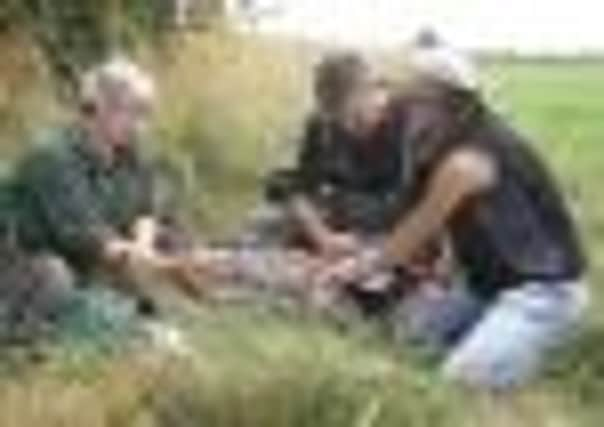Plotting bird paths and easing personal heartache


A group of volunteers working in the Lower Derwent Valley National Nature Reserve (NNR) have ringed more than 1,000 wild birds in a year.
Their efforts are part of a national ringing programme that gives conservationists a better understanding of the migration patterns and survival rates of a variety of birdlife.
Advertisement
Hide AdAdvertisement
Hide AdRinging also gives an insight into the changing nature of the wild bird population in the Lower Derwent Valley NNR, which covers Wheldrake, Thorganby, Skipwith Common, North Duffield Carrs, Ellerton Ings, Aughton Ings to Melbourne, East Cottingwith, the Pocklington Canal and Thornton Ellers.
Lucy Murgatroyd of Scarborough, one of the volunteers taking part, says, “Wading birds, such as redshank, snipe, lapwing, curlew and ruff, are fitted with coloured rings so that, if they travel to another area, people can tell where they were ringed without even catching them. All you need to do is submit the colours to the British Trust for Ornithology (BTO), which then tracks them.”
One of the team’s most surprising discoveries came when a gadwall duck that had been ringed as a duckling at Wheldrake Ings in 2006 turned up in Russia last year.
Lucy said: “I chose to get involved because they’ve always been a part of my life. My love of birds was passed on to me by my dad. I’ve spent many an hour sitting in a hide with him or out walking the cliffs at the coast, particularly at Filey, which is a favourite birding spot of ours.
Advertisement
Hide AdAdvertisement
Hide Ad“My dad sadly passed away the summer before I started to train to ring, but through ringing I found solace.
“I started training to ring in October 2009. I found it fascinating to be able to see and hold birds that I’d been used to watching from a hide.
“I dedicated a lot of my time to it, travelling to other areas to ring different birds to gain as much experience as possible.
“It all paid off as, this year, I moved on from training and qualified for my ‘C’ permit, which means you can legally ring on your own.
Advertisement
Hide AdAdvertisement
Hide Ad“I started ringing in the Lower Derwent Valley in June where they specialise in ringing ducks, geese and wading birds, which was all new to me, and so has helped my knowledge of wildfowl and waders greatly.”
Jean Thorpe of Malton, who is well known for her voluntary work caring for and rehabilitating sick and injured wildlife, is one of a number of trainee ringers here.
She was inspired to get involved after a ring provided her with invaluable information about a barn owl that she’d previously nursed back to health and released into the wild.
She said: “It was wonderful to learn more about what had happened to him after rehabilitation and know that my efforts had paid off.”
Advertisement
Hide AdAdvertisement
Hide AdMore than 900,000 birds are ringed in Britain and Ireland each year by around 2,600 trained ringers, most of whom are volunteers.
Nationally, the ringing programme is overseen by the British Trust for Ornithology (BTO) and its aim is to help conservationists learn more about how long birds live, and when and where they move.
Ringing the changes for research
British wildlife enthusiasts have been ringing birds for over 100 years.
It enables young birds to be monitored from the nest through to adulthood, providing information about how they survive the stresses of life and help experts to pinpoint the potential causes decline.
Advertisement
Hide AdAdvertisement
Hide AdThe BTO runs courses for people interested in training to ring birds. See: http://www.bto.org/volunteer-surveys/ringing/ringing-scheme.
Read Lucy Murgatroyd’s bird ringing blog to find out more about the work of the Lower Derwent Valley group: http://ldvnnr.blogspot.com